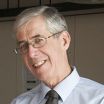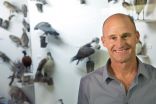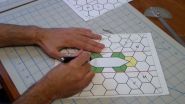Chickens and turkeys 'closer to dinosaur ancestors' than other birds
2014-12-11
(Press-News.org) New research from the University of Kent suggests that chickens and turkeys have experienced fewer gross genomic changes than other birds as they evolved from their dinosaur ancestor.
Professor Darren Griffin and a team at the University's School of Biosciences have conducted research that suggests that chromosomes of the chicken and turkey lineage have undergone the fewest number of changes compared to their ancient avian ancestor, thought to be a feathered dinosaur.
The Kent research is part of a study by a consortium of leading scientists into avian or bird genomes, which tell a story of species evolution. The living descendants of dinosaurs were thought to have undergone a rapid burst of evolution after most dinosaur species were wiped out. The detailed family tree of modern birds has however confused biologists for centuries and the molecular details of how birds arrived at the spectacular biodiversity of more than 10,000 species is barely known.
Professor Griffin explained: 'Bird genomes are distinctive in that they have more tiny microchromosomes than any other vertebrate group. These small packages of gene-rich material are thought to have been present in their dinosaur ancestors.
'We found that the chicken has the most similar overall chromosome pattern to its avian dinosaur ancestor.'
The research, which formed part of a vast study carried out over the past four years by the international Avian Phylogenomics Consortium, involved the analysis of the whole genome structure of the chicken, turkey, Pekin duck, zebra finch and budgerigar.
Professor Griffin and the other leaders of the research team ¬- Kent colleague Dr Michael Romanov as well as Dr Denis Larkin and Dr Marta Farré from the Royal Veterinary College, University of London - studied data from a total of 21 avian genomes and one reptile species. The team focused on the six best-assembled genomes to put together a karyotype - organised profile - of the dinosaur ancestor for each chromosome.
The researchers also found that the fastest rate of change had occurred in the zebra finch and budgerigar, consistent with more rapid speciation events in songbirds and their relatives.
INFORMATION:
The research paper, entitled Reconstruction of gross avian genome structure, organization and evolution suggests that the chicken lineage most closely resembles the dinosaur avian ancestor, is published in the open access journal BMC Genomics on 11 December 2014. See: http://www.biomedcentral.com/1471-2164/15/1060
Its authors are: Michael N Romanov, University of Kent; Marta Farré, Royal Veterinary College; Pamela E Lithgow, University of Kent; Katie E Fowler, University of Kent; Benjamin M Skinner, University of Cambridge; Rebecca O'Connor, University of Kent; Gothami Fonseka, University of Kent; Niclas Backström, Uppsala University; Yoichi Matsuda, Nagoya University; Chizuko Nishida, Hokkaido University; Peter Houde, New Mexico State University; Erich D Jarvis, Duke University Medical Center; Hans Ellegren, Uppsala University; David W Burt, University of Edinburgh; Denis M Larkin, Royal Veterinary College; and Darren K Griffin, University of Kent.
The paper is one of 23-paper series of first findings of the Avian Phylogenomics Consortium. Eight papers will appear in special issue of the journal Science on 12 December and 15 more in Genome Biology, GigaScience and other journals, including BMC Genomics. The full set of papers in Science and other journals can be accessed at: http://www.biomedcentral.com/series/avian
ELSE PRESS RELEASES FROM THIS DATE:
2014-12-11
An international team of scientists has completed the largest whole genome study of a single class of animals to date. To map the tree of life for birds, the team sequenced, assembled and compared full genomes of 48 bird species representing all major branches of modern birds including ostrich, hummingbird, crow, duck, falcon, parrot, crane, ibis, woodpecker and eagle species. The researchers have been working on this ambitious genetic tree of life, or phylogeny, project for four years.
As part of the Avian Phylogenomics Consortium -- comprised of more than 200 scientists ...
2014-12-11
NEW YORK, NY (December 11, 2014) Growing resistance to malaria drugs in Southeast Asia is caused by a single mutated gene inside the disease-causing Plasmodium falciparum parasite, according to a study led by David Fidock, PhD, professor of microbiology & immunology and of medical sciences (in medicine) at Columbia University Medical Center.
This finding provides public health officials around the world with a way to look for pockets of emerging resistance and potentially eliminate them before they spread.
Though malaria deaths have dropped by 30 percent worldwide since ...
2014-12-11
Targeted therapies are a growing and groundbreaking field in cancer care in which drugs or other substances are designed to interfere with genes or molecules that control the growth and survival of cancer cells. Now, scientists at Virginia Commonwealth University Massey Cancer Center and VCU Institute of Molecular Medicine (VIMM) have identified a novel interaction between a microRNA and a gene that could lead to new therapies for the most common and deadly form of brain tumor, malignant glioma.
In a study recently published in the journal Neuro-Oncology, a team of scientists ...
2014-12-11
Advances in treatment for human immunodeficiency virus (HIV) have made it possible for people with HIV to survive much longer. As they age, however, many experience impaired thinking, memory loss, mood swings and other evidence of impaired mental function.
To stop these changes, scientists have to learn what is causing them. One possibility researchers are considering is that long-term infections with other pathogens, common in HIV-positive patients, are affecting the brain. But a new study has eliminated one of their prime suspects: the hepatitis C virus, which infects ...
2014-12-11
Lincoln, Neb., Dec. 11, 2104 -- A University of Nebraska-Lincoln researcher has contributed to discoveries about bird evolution as part of a new study that sequenced the complete genomes of 45 avian species.
Published Dec. 11 in the journal Science, the study found that avian genomes -- the complete archive of genetic material present in cells -- have exhibited surprisingly slow rates of evolution when compared with their mammalian counterparts.
Jay Storz, a Susan J. Rosowski Associate Professor of Biological Sciences, led a research group that assisted the study by examining ...
2014-12-11
The fruits and vegetables provided at school deliver an important dietary boost to low income adolescents, according to Meghan Longacre, PhD and Madeline Dalton, PhD of Dartmouth Hitchcock's Norris Cotton Cancer Center and The Hood Center for Children and Families. In a study released in Preventive Medicine, Longacre and Dalton found that fruit and vegetable intake was higher among low income adolescents on days when they consumed meals at school compared to days when low income adolescent were not in school. The opposite was true for high income adolescents who consumed ...
2014-12-11
PITTSBURGH--The 2013 Boston Marathon bombing motivated mass expressions of fear, solidarity, and sympathy toward Bostonians on social media networks around the world. In a recently released study, researchers at the University of Pittsburgh and Cornell University analyzed emotional reactions on Twitter in the hours and weeks following the attack.
The study is the first large-scale analysis of fear and social-support reactions from geographically distant communities following a terrorist attack. The findings show the extent to which communities outside of Boston expressed ...
2014-12-11
Origami is capable of turning a simple sheet of paper into a pretty paper crane, but the principles behind the paper-folding art can also be applied to making a microfluidic device for a blood test, or for storing a satellite's solar panel in a rocket's cargo bay.
A team of University of Pennsylvania researchers is turning kirigami, a related art form that allows the paper to be cut, into a technique that can be applied equally to structures on those vastly divergent length scales.
In a new study, the researchers lay out the rules for folding and cutting a hexagonal ...
2014-12-11
A CEO's natural sunny disposition can have an impact on the way the market reacts to announcements of company earnings, according to research from the University of British Columbia's Sauder School of Business.
The study shows that leaders' inclinations to express themselves with optimism carries over into their tone when disclosing company performance - a tendency that can create an uptick in stock price.
"Ours is the first study to look at the effect of how managers naturally convey themselves," says Sauder Assistant Professor Jenny Zhang, who co-authored the paper. ...
2014-12-11
Senescent cells have a bad-guy reputation when it comes to aging. While cellular senescence - a process whereby cells permanently lose the ability to divide when they are stressed - suppresses cancer by halting the growth of premalignant cells, it is also suspected of driving the aging process. Senescent cells, which accumulate over time, release a continual cascade of inflammatory cytokines, chemokines, growth factors and proteases. It is a process that sets up the surrounding tissue for a host of maladies including arthritis, atherosclerosis and late life cancer. But ...
LAST 30 PRESS RELEASES:
[Press-News.org] Chickens and turkeys 'closer to dinosaur ancestors' than other birds




